Connections (July-August 2022)
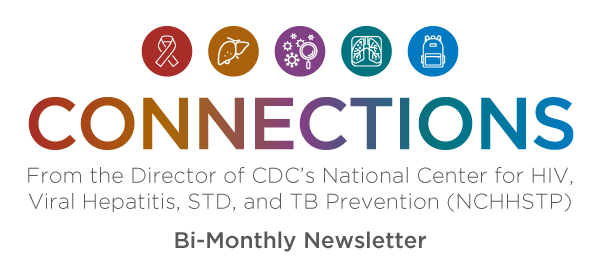
July – August 2022
From the Director - Jonathan Mermin, MD, MPH
Dear Colleagues:
At NCHHSTP, we have been looking at our workplace environment, diversity, and the practices we use to recruit and retain the very best. We are committed to ensuring a diverse workforce that reflects the different populations we serve.
Recently, we analyzed our data on workforce demographics. From 2010 to 2021, racial and ethnic minority representation in the NCHHSTP workforce increased from 45% to 54%, with increases across government pay levels. Although positive news, we continue to have a low proportion of Hispanic/Latino staff and a drop in the proportion of minority staff in the highest-level positions.
We learned a lot from this analysis and these data will guide our strategy to improve workforce diversity. We believe establishing a diverse and inclusive workforce is central to greater success in our work to prevent and treat HIV, viral hepatitis, STDs, and TB, to protect and support the health of our nation’s youth, and to increase health equity.
NCHHSTP has a longstanding mission to promote health equity and has invested in extensive programs, partnerships, and activities to advance this mission. We are committed to advancing equity through recruitment, training, and retention strategies focused on ensuring current and future staff have the opportunity to attain their highest level of professional achievement possible.
In early 2022, we launched the Careers webpage to help expand recruitment methods. We implemented a learning opportunity highlighting different career paths at NCHHSTP called “a Day in the Life”. By creating a learning event for internal staff and external partners, it also became a communications and recruitment strategy, and a place for NCHHSTP staff to share their career experiences via “a Day in the Life” to help inform, entice, and excite external future employees to work at NCHHSTP and inspire staff.
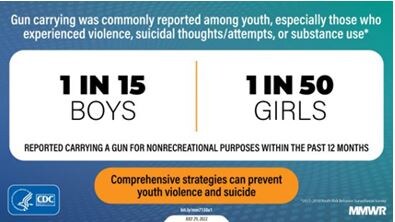
An article recently published in CDC’s Morbidity and Mortality Report (MMWR) reviewed data from CDC’s 2017 and 2019 Youth Risk Behavior Survey that showed 1 in 15 male and 1 in 50 female high school students carried a gun for reasons other than hunting or sport at least once in the past 12 months. The article reports that gun carrying was much higher among students who had experienced violence, suicidal ideation or attempts, or substance use than among those who had not. These results underscore the importance of understanding and addressing the root causes of youth violence and suicide.
Summary Sources
- Simon TR, Clayton HB, Dahlberg LL, David-Ferdon C, Kilmer G, Barbero C. Gun carrying among youths, by demographic characteristics, associated violence experiences, and risk behaviors—United States, 2017–2019. MMWR Morb Mortal Wkly Rep 2022;71(30):953–7.
Monkeypox Response
The Situation Summary provides the latest information.
CDC released Interim Guidance for Prevention and Treatment of Monkeypox in Persons with HIV Infection.
White House names Demetre Daskalakis, M.D., M.P.H as monkeypox deputy: President Biden Announces Team to Lead Monkeypox Response | The White House
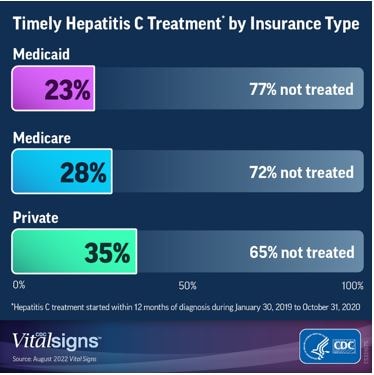
Vital Signs
CDC published a Vital Signs, Hepatitis C Treatment Among Insured Adults – United States, 2019-2020, on August 9, 2022. The report finds that few insured people with hepatitis C diagnosis receive timely direct-acting antiviral (DAA) treatment, even though hepatitis C is curable. Increasing access to hepatitis C treatment is essential for reducing viral hepatitis-related disparities and achieving hepatitis C elimination. Estimates in the report show that overall less than 1 in 3 people with health insurance get DAA treatment for hepatitis C within a year of diagnosis and treatment is lowest among patients in state-administered Medicaid plans, with less than 1 in 4 Medicaid recipients (23%) being treated within a year of diagnosis. The report calls for removing barriers to treatment as a critical step to get more people treated for hepatitis C and save more lives.
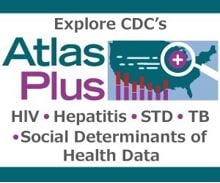
CDC’s AtlasPlus
What’s New in NCHHSTP’s AtlasPlus: NCHHSTP added new 2020 data on STD case reports at the national, state, and county-levels. Data stratified by age group, sex, and race/ethnicity are also available.
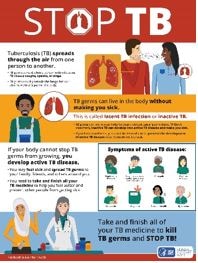
CDC Stop TB Poster
CDC has a new look for the Stop TB poster. The poster can be used by TB programs and other healthcare settings to help educate people with TB disease and latent TB infection, as well as people at risk for TB. To download copies in English and Spanish, please check out the CDC website. To order print copies, please visit CDC-INFO on Demand.
EHE in Action: A Digital Storytelling Project

As part of The Ending the HIV Epidemic in the U.S (EHE) initiative, CDC is featuring communities across the country that are mobilizing to end their local HIV epidemics in a digital storytelling project. These stories highlight smart innovation, share lessons learned from successful programs, and profile the community members leading HIV prevention efforts. One success story highlights how two providers in rural Kentucky used EHE funding to incorporate innovative telehealth models into existing HIV and other health services during the COVID-19 pandemic. Another success story details how CDC worked to overcome HIV service challenges presented during the COVID-19 pandemic by implementing a direct-to-consumer, self-test distribution project. Ten thousand tests were distributed as a result of this project.
EHE Infographics
The Ending the HIV Epidemic in the U.S (EHE) initiative aims to reduce new HIV infections by 90% by 2030. CDC is tracking the nation’s progress to reach this goal and has released new web-based infographics that provide a user-friendly summary of CDC’s HIV data organized by the EHE pillars: Diagnose, Treat, Prevent, and Respond.
LGBTQ+ Focused Professional Development (PD) web pages
CDC created a series of web pages on the evaluation of LGBTQ+ -focused professional development (PD). These new web pages are primarily meant for schools and school districts offering training to educators on how to create safe schools for LGBTQ+ students. The web pages include learning objectives and sample items to assess individuals’ knowledge, attitudes, and practices related to core competencies and to assess a school’s or school district’s PD offerings for teachers and other staff to help ensure schools are safe for all youth.
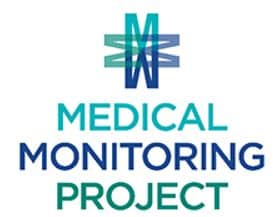
Medical Monitoring Project: 2020 Cycle Report
CDC published data from the 2020 cycle (June 2020–May 2021) of the Medical Monitoring Project (MMP). MMP is an annual, cross-sectional complex sample survey that reports nationally representative estimates of behavioral and clinical characteristics of adults with diagnosed HIV infection in the United States. The latest MMP report shows that 80% of adults with diagnosed HIV did not miss any HIV medical appointments during the past 12 months, 95% were currently taking ART, and 62% took all prescribed ART doses during the past 30 days. Top reasons for not currently taking ART included: money or insurance problems (37%), the health care provider never discussed restarting ART (29%), or the person thought ART would make them sick or harm them (20%). For more information on the MMP, please see the full report.
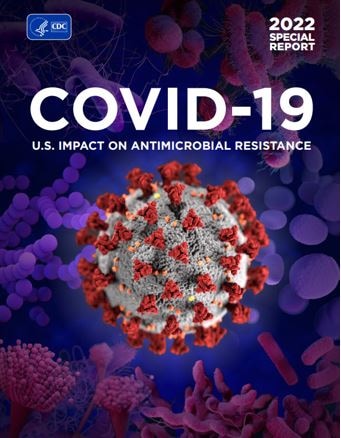
New Data on Antimicrobial Resistance
CDC recently released COVID-19: U.S. Impact on Antimicrobial Resistance, Special Report 2022. This report indicates that much of the progress made in the United States in previous years combating antimicrobial resistance was lost, in large part, due to the effects of the COVID-19 pandemic. The report includes an update on drug-resistant tuberculosis and drug-resistant gonorrhea.
Progress toward TB elimination has slowed in recent years as the COVID-19 pandemic strained public health services, including TB services. As previously published in Reported Tuberculosis in the United States, 2020, drug-resistant TB cases in the United States declined 28% from 2019 to 2020, similar to an overall decline in TB cases of 19%. This is probably due to multiple factors related to the COVID-19 pandemic. CDC and public health partners will continue to monitor drug-resistant TB cases to better understand data trends and identify the most effective TB control and prevention strategies.
The estimated number of drug-resistant gonorrhea infections is not available for 2020 due to the COVID-19 pandemic; however, increases seen in previous years remain alarming. During 2017-2019, data show an increase in infections caused by gonorrhea with resistance to any of the six antibiotics currently or historically recommended to treat it. Public health action and continued surveillance of treatment practices are critical to ensure patients receive the highest quality of care, and to address the emerging threat of antimicrobial-resistant gonorrhea.
For more information and resources, visit CDC’s COVID-19 and Antibiotic Resistance webpage.
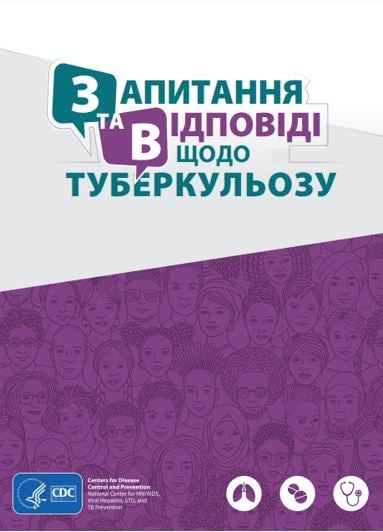
Uniting for Ukraine: Information for TB Programs
The Uniting for Ukraine Program is a pathway for Ukrainian citizens and their immediate family members who are outside the United States to come to the United States and stay temporarily. Ukrainians participating in the Program must meet specific requirements, including a health attestation for TB screening. CDC has launched a new webpage with information, helpful links, and Ukrainian-language patient resources to help TB programs involved in the program.
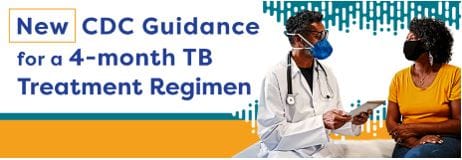
Medscape Publication
Medscape published “New 4-month TB Treatment Regimen: 5 Things to Know.” The article highlights CDC’s interim guidance Morbidity and Mortality Weekly Report to treat drug-susceptible TB disease in the United States.
New Social Determinants of Health (SDOH) videos
Please watch the five-video SDOH series from CDC’s NCHHSTP. The series includes one from the Division of Viral Hepatitis Director, Carolyn Wester, MD, MPH, and from the Division of STD Prevention Director, Leandro Mena, MD, MPH. Both share their personal commitment to achieving health equity with a focus on the diseases and infections we work so hard to prevent.
CDC is encouraged by the initial data presented at the 2022 International AIDS Conference on the use of doxycycline post-exposure prophylaxis (doxy-PEP) to prevent gonorrhea, chlamydia, and syphilis infections in the U.S. Funded by the National Institutes of Health, the study showed that doxy-PEP demonstrated significant effectiveness and tolerability against these common STIs in gay and bisexual men and transgender women with HIV or taking HIV pre-exposure prophylaxis. Here are examples of media coverage around this data:
- Taking an Antibiotic After Sex Could Help Curb Three Common STDs – Science
- Taking doxycycline after sex can prevent STIs, another study finds Healio.com/Infectious Disease News
- Global AIDS Fight at Crossroads After Setbacks During COVID-19 – Associated Press
- Doxycycline Significantly Reduces STIs in MSM and Transgender Women – The Body Pro
- Post-Exposure Doxycycline Reduces STIs – MedPage Today
To get the latest news and announcements from our Center, check out the NCHHSTP newsroom.
Dr. Jonathan Mermin
@DrMerminCDC
- March 10: National Women and Girls HIV/AIDS Awareness Day
- March 20: National Native HIV/AIDS Awareness Day
- March 24: World TB Day
- April 10: National Youth HIV/AIDS Awareness Day
- April 18: National Transgender HIV Testing Day

Mary Cashin
Do you have feedback, story ideas, content you would like to see in the newsletter? Contact us
Get Connections. Your more interesting inbox awaits!
Subscribe now
Mary Cashin
Do you have feedback, story ideas, content you would like to see in the newsletter? Contact us
Get Connections in your inbox









